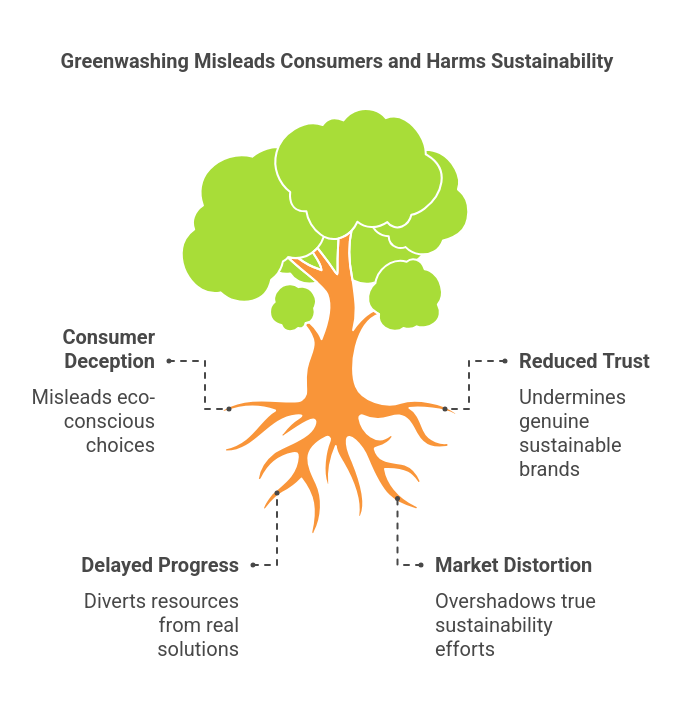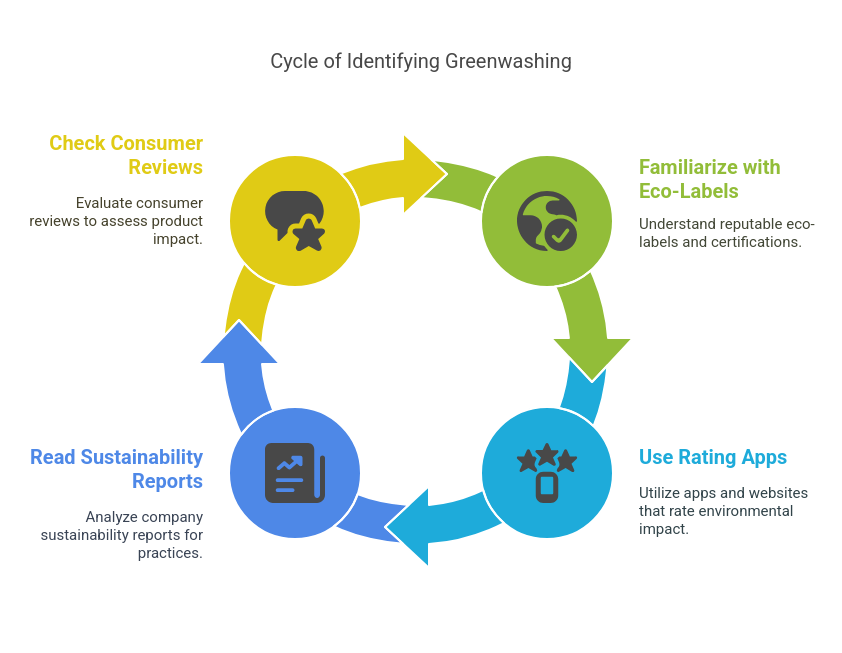One in four climate-related ESG risk occurrences worldwide, up from one in five in the previous year’s report, are linked to greenwashing, according to research from data science business RepRisk.
Businesses are eager to highlight their environmentally friendly procedures and goods nowadays when environmental awareness is becoming more and more crucial. But let’s understand that not all green claims, nevertheless, are true. A practice known as “greenwashing” occurs when businesses falsely portray their goods or practices as ecologically beneficial.
Making educated decisions and promoting true sustainability need knowing how to spot and steer clear of these false eco-claims.
What is Greenwashing?
Greenwashing is a marketing strategy used to make a company appear more environmentally friendly than it truly is. This can involve vague claims, misleading labels, or outright false information. The aim is to attract eco-conscious consumers without making substantial efforts to reduce the company’s environmental impact.
Its name comes from combining the terms “green,” which stands for environmental advantages, with “whitewashing,” which describes the practice of hiding wrongdoings. By telling “green lies,” greenwashing tries to trick customers into thinking a business is more environmentally conscious than it actually is.
Why is Greenwashing Harmful?
Greenwashing has several negative effects:
- Consumer Deception: It misleads consumers into believing they are making environmentally responsible choices when they are not.
- Reduced Trust: It undermines trust in genuinely sustainable brands.
- Delayed Progress: It hampers real environmental progress by diverting attention and resources from truly sustainable practices.
- Market Distortion: It creates an uneven playing field where genuine efforts to be sustainable are overshadowed by false claims.

Common Tactics of Greenwashing
Understanding the tactics used in greenwashing can help you spot misleading claims. Here are some common strategies:
- Vague Claims: Using terms like “green,” “natural,” or “eco-friendly” without specific evidence or standards.
- Hidden Trade-offs: Highlighting one positive aspect while ignoring other significant negative impacts.
- Irrelevant Claims: Promoting an environmental benefit that is already a legal requirement or irrelevant to the product.
- Lesser of Two Evils: Claiming a product is greener than others in its category, which are all harmful.
- No Proof: Making claims without providing verifiable or reliable evidence.
- False Labels: Using fake third-party endorsements or creating misleading certifications.
How to Identify Greenwashing?
Being a vigilant and informed consumer is key to identifying greenwashing. Here are steps you can take:
- Research the Company: Look into the company’s overall environmental practices. Are they transparent about their sustainability efforts? Do they provide detailed reports and data?
- Read the Fine Print: Scrutinize labels and claims. Look for specific, measurable information rather than vague statements.
- Assess the Whole Product: Consider the product’s lifecycle, including production, usage, and disposal. A product might be labeled eco-friendly but have significant environmental impacts elsewhere in its lifecycle.
- Beware of Buzzwords: Be skeptical of buzzwords without substance. Terms like “green,” “eco,” and “natural” should be backed by concrete evidence.
How to Support Genuine Sustainability?
While it’s important to avoid greenwashing, supporting genuinely sustainable companies like the Hartek Group is equally crucial. Here’s how you can do it:
- Support Transparent Brands: Choose companies that are open about their sustainability efforts and provide detailed, verifiable information.
- Prioritize Quality Over Quantity: Opt for durable, high-quality products that have a longer lifespan, even if they come at a higher initial cost.
- Reduce, Reuse, Recycle: Focus on reducing consumption, reusing products, and recycling whenever possible.
- Advocate for Change: Encourage companies to adopt genuine sustainable practices and hold them accountable for their claims.
- Educate Yourself and Others: Stay informed about environmental issues and educate others on how to identify and avoid greenwashing.
Tools & Resources for Identifying Greenwashing
To further aid in recognizing greenwashing, utilize various tools and resources:
- Eco-Labels and Certifications: Familiarize yourself with reputable eco-labels and certifications.
- Apps and Websites: Use apps and websites that rate companies and products on their environmental impact, such as Good On You (for fashion) and the Environmental Working Group (for household products).
- Sustainability Reports: Read sustainability reports from companies to get a comprehensive view of their practices.
- Consumer Reviews: Look at consumer reviews and feedback to gauge the actual performance and environmental impact of products.

Conclusion
Greenwashing is a prevalent issue that undermines genuine sustainability efforts. By being aware of the tactics used in greenwashing and taking steps to identify and avoid misleading claims, you can make more informed, environmentally responsible choices. Support transparency, quality, and real sustainability to contribute to a healthier planet and a more honest marketplace.
Through vigilance and education, consumers can play a crucial role in driving companies toward true sustainability, ensuring that eco-friendly claims are backed by real, impactful actions.
FAQ’s:-
1. What is greenwashing?
Greenwashing is a deceptive marketing tactic where companies falsely present their products or practices as eco-friendly to attract consumers.
2. Why is greenwashing harmful?
Greenwashing misleads consumers, undermines trust in genuine sustainable brands, and diverts resources from real environmental progress.
3. How can consumers identify greenwashing?
Consumers can identify greenwashing by researching company practices, verifying claims, and being cautious of vague or unverified eco-labels.
4. What are common greenwashing tactics?
Common tactics include vague claims, hidden trade-offs, irrelevant eco-benefits, and fake certifications or labels.
5. How can consumers support genuine sustainability?
Support transparent brands, prioritize durable products, reduce waste, and advocate for authentic environmental practices.
Share:
Explore More
Keep up-to-date with the most trending news stories that are shaping the world today.







